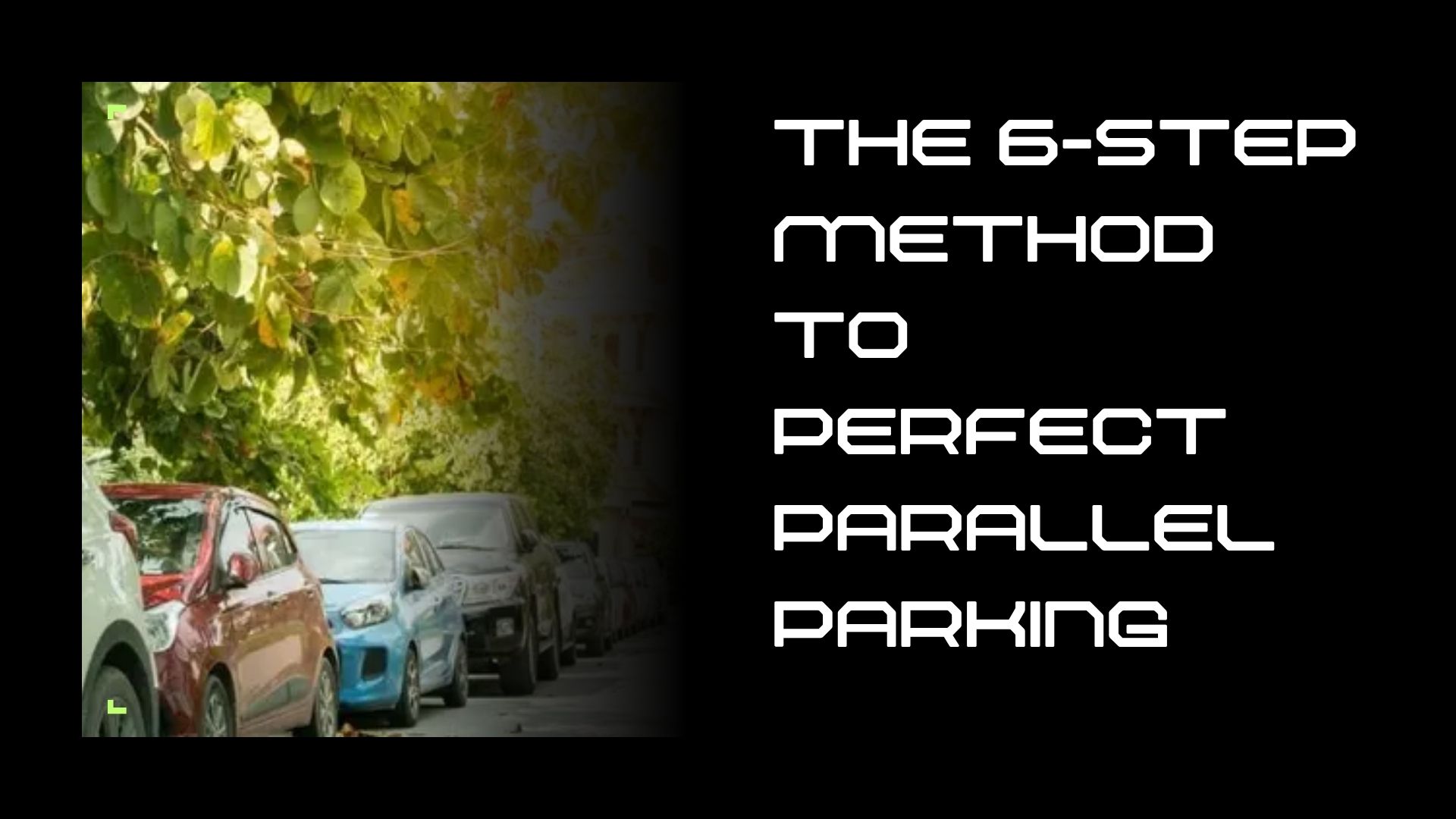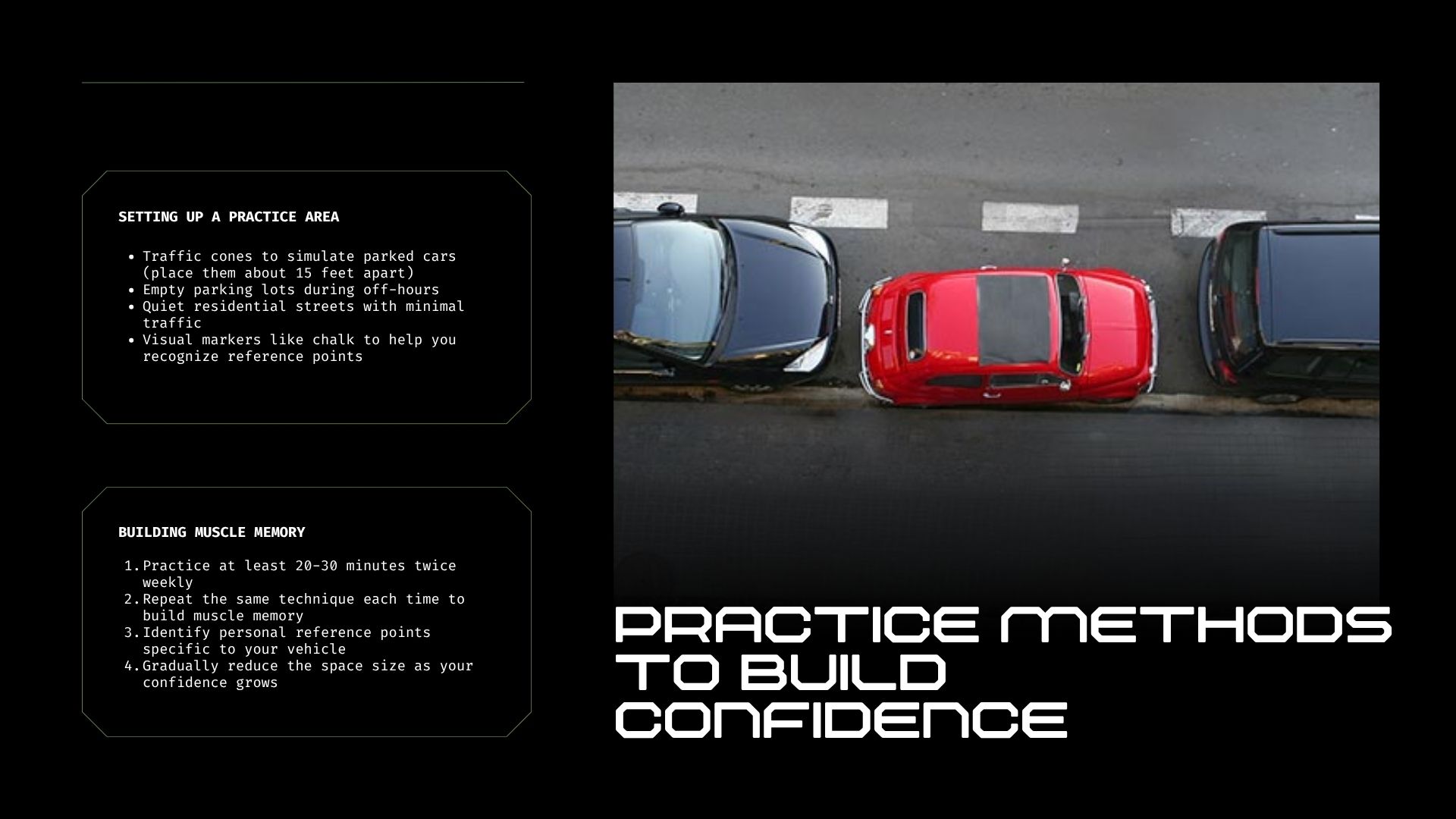Does the mere thought of parallel parking make your palms sweat? You're not alone. Nearly half of American drivers suffer from "parallelophobia" – the fear of parallel parking. At New York City, we see this anxiety in new drivers every day, but we're here to tell you that mastering this essential skill is absolutely within your reach.
Whether you're preparing for your New York State driver's test or simply want to navigate the crowded streets of NYC with confidence, this comprehensive guide will transform you from nervous novice to parallel parking pro.
What you'll learn in this guide:
- The psychology behind parking anxiety and how to overcome it
- A foolproof 6-step method that works for vehicles of all sizes
- Practice techniques that build muscle memory and confidence
- Specific requirements for passing the NY State driving exam
- Legal parking regulations that every New York driver must know
Let's start your journey to becoming an expert in parallel parking!
Parallel Parking Basics
Understanding the fundamental principles of parallel parking is the first step toward mastering this essential skill. Before diving into the step-by-step technique, let's explore the core concepts that make successful parallel parking possible, regardless of vehicle size or parking space dimensions.
What Is Parallel Parking?
Parallel parking is the technique of positioning your vehicle in line with other parked cars, parallel to the curb or road edge. This skill is especially crucial in urban environments like New York City, where parking spaces are limited and street parking is the norm.
Many driving instructors consider parallel parking the most challenging maneuver to master, but understanding the basic concepts makes it much more approachable.
Why Do Many Drivers Struggle?
The difficulty with parallel parking stems from several factors:
- Spatial awareness challenges: Judging distances between your vehicle and others
- Reverse maneuvering: Most drivers are less comfortable driving backward
- Multiple-step process: Requires coordinating several actions in sequence
- Pressure situations: Often performed with traffic waiting behind you
Benefits of Mastering Parallel Parking
Taking the time to learn proper parallel parking techniques offers several advantages:
|
Benefit |
Description |
|
More parking options |
Access to abundant street parking throughout NYC |
|
Test confidence |
Required skill for passing your NY driving test |
|
Time savings |
No more circling blocks looking for easier spots |
|
Reduced stress |
Eliminate anxiety when only parallel spots are available |
|
Cost savings |
Avoid expensive parking garages in the city |
Space Requirements for Successful Parking
For beginners, we recommend finding a spot that is approximately 1.5 times the length of your vehicle. More experienced drivers can manage with less space, but when learning, give yourself this extra margin for error.
According to the NY State Driver's Manual, in your final parking position, your wheels must be no more than one foot (30 cm) from the curb. This standard is enforced during driving tests and through parking regulations.
Essential Preparation Before You Start
Proper preparation creates the foundation for successful parallel parking and can significantly reduce your stress level during the maneuver. Taking a few moments to complete these preliminary steps will dramatically increase your chances of executing a perfect parallel park on your first attempt.
Mirror Adjustment and Vehicle Awareness
Before attempting to parallel park, ensure that all your mirrors are properly adjusted for maximum visibility:
- Side mirrors: Position to minimize blind spots
- Rearview mirror: Adjust for clear view behind your vehicle
- Understanding vehicle dimensions: Being aware of how much space your car occupies
Safety Check Sequence
Always follow this safety sequence before initiating a parallel parking maneuver:
- Check rearview mirror for approaching traffic
- Signal your intention to park with your turn indicator
- Reduce speed appropriately as you approach the parking space
- Scan for pedestrians and cyclists who may be crossing behind you
- Check blind spots by looking over both shoulders
Selecting the Right Parking Space
Not all open spaces are suitable for parallel parking, especially for beginners. Here's how to identify an appropriate spot:
- Length assessment: Look for a space at least 1.5 times your vehicle length
- Width consideration: Ensure there's enough room to maneuver (typically 8 feet wide)
- Obstruction check: Verify no fire hydrants, driveways, or crosswalks in the space
- Traffic flow: If possible, choose a spot with less passing traffic for your first attempts
Pro Tip: In New York City, spaces near fire hydrants (within 15 feet) are illegal parking spots. Always verify that your chosen space complies with local parking regulations.
Communication with Other Drivers
Using your turn signal is not just a legal requirement-it's an essential communication tool that:
- Alerts drivers behind you of your intention to park
- Reduces the chance of impatient drivers attempting to pass at the wrong moment
- Gives pedestrians warning that your vehicle will be maneuvering
Remember, in congested New York traffic, clear communication prevents accidents and frustration.

The 6-Step Method to Perfect Parallel Parking
The key to mastering parallel parking lies in breaking this seemingly complex maneuver into manageable steps. At New York City, we've refined this technique over thousands of student sessions to create a foolproof method that works for vehicles of all sizes.
Step 1: Finding and Approaching the Space
When you spot a potential parking space:
- Assess the size of the space to ensure it's adequate for your vehicle
- Signal your intention to park using your turn indicator
- Position your vehicle parallel to the car in front of the empty space
- Maintain approximately 2-3 feet of distance between your car and the parked vehicle
- Stop your vehicle when your rear bumper aligns with the rear bumper of the car beside you
New York Driving Instructor Tip: In the NY state driving test, examiners look for proper signaling and space assessment as part of your parallel parking evaluation.
Step 2: Initial Positioning and Setup
This critical positioning step creates the perfect angle for entry:
- Check all mirrors and blind spots for pedestrians, cyclists, and other vehicles
- Shift into reverse and keep your foot on the brake
- Look over both shoulders to ensure the area behind is clear
- Align your side mirror with the driver's side mirror of the car in front (creates a perfect reference point)
- Take a deep breath and prepare for the reverse maneuver
Step 3: Beginning the Reverse Maneuver
Now the actual parking begins:
- Turn your steering wheel fully to the right (toward the curb)
- Release the brake slowly and begin backing up at a controlled pace
- Continue reversing until your car is at approximately a 45-degree angle to the curb
- Maintain awareness of your surroundings using mirrors and looking over your shoulder
- Move slowly - rushing this step is the most common cause of parking errors
Step 4: Straightening Your Vehicle
Once your vehicle is properly positioned:
- Stop when your front door handle aligns with the rear bumper of the car in front
- Straighten your steering wheel while still in reverse
- Continue backing up slowly in a straight line
- Monitor the distance to the vehicle behind you using your mirrors
- Prepare for the final positioning adjustment
Pro Tip: Using the back-up camera can be helpful, but don't rely on it exclusively. Developing spatial awareness through your mirrors ensures you can park successfully in any vehicle.
Step 5: Final Positioning
As you approach the final position:
- Begin turning your steering wheel fully to the left when your front bumper clears the rear bumper of the car ahead
- Continue backing slowly while monitoring both the car behind and the curb
- Stop before contacting the vehicle behind you
- Check your position relative to the curb - you should be gradually getting closer
- Adjust as needed by making small steering corrections while continuing to reverse
Step 6: Final Adjustments
Perfect your parking position:
- Shift to drive and turn your wheels straight
- Move forward slightly if necessary to center your car in the space
- Position your vehicle equally between the cars front and back (about 1-2 feet of space)
- Ensure you're within one foot of the curb as required by New York parking regulations
- Set your parking brake and put your transmission in park
|
Common Reference Points |
What They Tell You |
|
Side mirror alignment |
When to begin turning |
|
Front door handle position |
When to straighten wheels |
|
Front bumper clearing rear car |
When to turn in opposite direction |
|
Equal space front/back |
Proper final positioning |
This 6-step method may seem detailed, but with practice, it becomes second nature. Most of our students report that after 5-7 dedicated practice sessions, they can parallel park confidently in spaces they would have previously avoided.
Remember that steering wheel positioning is the most critical element. The three main wheel positions-fully right, straight, and fully left-must be executed at precisely the right moments for a smooth parking maneuver.
Driving Test Note: New York State driving examiners are looking for smooth execution, proper signaling, and awareness of surroundings throughout the parallel parking process. Practicing this 6-step method ensures you'll meet all these requirements.
Common Challenges and How to Overcome Them
Even experienced drivers occasionally struggle with parallel parking challenges. Here are solutions to the most frequent issues:
Correcting Misalignment
If you find your vehicle is not properly aligned with the curb:
- Don't panic - misalignment is a common issue
- Pull out completely and reset your position
- Start the maneuver again with proper initial positioning
- Make smaller steering adjustments during critical turning points
Pro Tip: It's always better to start over than to force your vehicle into a poorly aligned position, which can damage your tires and wheels on the curb.
Managing Tight Spaces
As you gain confidence, you'll be able to tackle tighter parking spaces:
- Use your side mirrors more aggressively to monitor distances
- Make multiple small adjustments rather than one large movement
- Practice the "triangle method" - visualizing your car's path as a triangle
- Learn your vehicle's turning radius to maximize maneuverability
Parallel Parking on Hills
Hill parking requires additional steps for safety:
|
Uphill (Front Facing Uphill) |
Downhill (Front Facing Downhill) |
|
Turn wheels AWAY from curb |
Turn wheels TOWARD curb |
|
Apply parking brake firmly |
Apply parking brake firmly |
|
Put in 1st gear (manual) or "Park" (automatic) |
Put in 1st gear (manual) or "Park" (automatic) |
The New York State Driver's Manual emphasizes that proper wheel positioning prevents your vehicle from rolling into traffic if your brakes fail.
Overcoming Parking Anxiety
Parking anxiety affects many drivers, but these techniques help:
- Practice in empty lots before attempting street parking
- Visualize successful parking before beginning the maneuver
- Use progressive practice - start with larger spaces and gradually work toward smaller ones
- Remember that even experienced drivers occasionally need multiple attempts

Practice Methods to Build Confidence
Consistent and purposeful practice is the bridge between understanding parallel parking theory and executing it flawlessly on New York City streets. Implementing these structured practice techniques will accelerate your learning curve and build the muscle memory necessary for confident parallel parking in any situation.
Setting Up a Practice Area
Create a safe practice environment using:
- Traffic cones to simulate parked cars (place them about 15 feet apart)
- Empty parking lots during off-hours
- Quiet residential streets with minimal traffic
- Visual markers like chalk to help you recognize reference points
Building Muscle Memory
Consistent practice is the key to mastering parallel parking:
- Practice at least 20-30 minutes twice weekly
- Repeat the same technique each time to build muscle memory
- Identify personal reference points specific to your vehicle
- Gradually reduce the space size as your confidence grows
Parallel Parking for Your Driver's Test
The parallel parking portion of the New York State driving test often causes the most anxiety for new drivers, but it doesn't have to be a source of stress. Understanding exactly what the examiners are looking for and practicing to meet these specific standards will help you approach this section of your road test with confidence and composure.
New York State Test Requirements
The NYS driving test has specific parallel parking expectations:
- Your final position must be within one foot of the curb
- You must signal appropriately throughout the maneuver
- The examiner will assess your observation skills (mirror and blind spot checks)
- Your vehicle must be positioned with equal space front and back
- The entire process should be completed with smooth control
Common Test Mistakes to Avoid
Don't lose points for these frequent errors:
- Forgetting to signal your intention to park
- Hitting the curb (automatic fail in many cases)
- Excessive adjustments (more than 3-4 repositionings)
- Poor observation (failing to check mirrors and blind spots)
- Final position too far from the curb (more than one foot)
Legal Considerations and Regulations
Knowing where and how you can legally park in New York City is just as important as mastering the physical technique of parallel parking. The city's complex parking regulations protect public safety, ensure traffic flow, and manage limited parking resources-but they can result in substantial fines when violated. Understanding these rules will save you from costly tickets and unexpected towing situations.
New York Parking Regulations
Understanding parking regulations is essential in New York:
- NO PARKING: You can temporarily stop to load/unload merchandise or passengers
- NO STANDING: You can temporarily stop only to load/unload passengers
- NO STOPPING: You can stop only to obey traffic controls or prevent conflicts
Additional restrictions prevent parking:
- Within 15 feet of a fire hydrant
- Within 20 feet of a crosswalk
- Within 30 feet of a stop sign or traffic light
- In a crosswalk or intersection
- On a bridge or in a tunnel
Reserved Parking Considerations
Be aware of spaces reserved for people with disabilities:
- Look for the international symbol of access (wheelchair symbol)
- Avoid parking in or blocking access aisles with diagonal striping
- Fines for violations are substantial ($50-$150 plus surcharges)
Conclusion
Mastering parallel parking is achievable for every driver with proper technique and practice. The key elements to remember are:
- Proper initial positioning sets you up for success
- Consistent mirror usage keeps you aware of your surroundings
- Steady, slow movements give you control throughout the process
- Regular practice builds muscle memory and confidence
- Understanding local regulations keeps you legal and safe
At New York City, we've helped thousands of drivers overcome their parking anxiety and become parallel parking experts. Remember that even experienced drivers occasionally need multiple attempts-perfection comes with practice.
The next time you spot a parallel parking space, don't drive past it in fear. Apply the techniques from this guide, take your time, and embrace the opportunity to improve your skills. Before long, you'll be parallel parking with the confidence of a lifelong New Yorker!
FAQ
-
What is the hardest part of parallel parking?
The most challenging aspect is usually judging the precise moment to transition from backing at an angle to straightening the wheels. Using consistent reference points helps overcome this difficulty.
-
How much space do I need to parallel park safely?
Beginners should look for spaces approximately 1.5 times the length of their vehicle. Experienced drivers can manage with as little as 1.2 times their vehicle length.
-
How close to the curb should I be when parallel parked?
According to New York State regulations, your vehicle must be within one foot (30 cm) of the curb when properly parked.
-
What's the best way to practice parallel parking?
Setting up cones in an empty parking lot provides a stress-free environment to master the technique before attempting it on busy streets.
-
How do I know if a parking space is big enough?
A good rule of thumb: if the space appears to be about 3 feet longer than your vehicle on each end, it's likely adequate for beginning parallel parkers.

 Español
Español